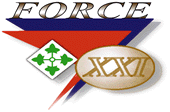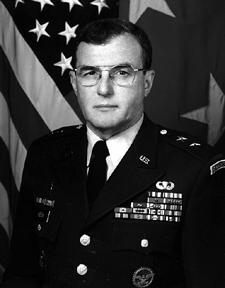![]() 1st Battalion 22nd Infantry
1st Battalion 22nd Infantry ![]()
Force XXI Overview
1997


Army Maj. Gen. Paul Kern
commands 4th Infantry Division at Fort Hood, Texas.
The division's 1st Brigade Combat Team, known as
Force XXI, is an experimental force for the 21st
century.
U.S. Army Photo
March 1997
By Linda D. Kozaryn American Forces Press Service FORT IRWIN, Calif. -- Changing the way the military thinks, trains and fights is a major undertaking. Ask Maj. Gen. Paul Kern. The Army's 4th Infantry Division (Mechanized) commander will readily admit change is hard. Kern's 1st Brigade Combat Team at Fort Hood, Texas, is known as Force XXI. It's a mechanized infantry brigade being transformed into a high-tech, futuristic force as part of the Army's advanced warfighting experiment.
For more than two years, Force XXI soldiers have been developing new skills, strategies and equipment for the 21st century battlefield. The goal is to create a sustainable, versatile, more lethal force to deal with future threats and contingencies.
Force XXI soldiers work side by side with industrial designers, acquisition specialists, trainers and strategists. They take equipment prototypes fresh from defense contractors' drawing boards and put them to use to determine what works and what doesn't. If a new tool doesn't do the job, it's sent back, and in some cases, fixed overnight.
"None of what we're doing comes easy," Kern said. "It's a lot of hard work by soldiers. It's a lot of hard work by industry. We're trying to push the technology to its limits to find out where the breaking points are."
When Force XXI soldiers first got their new computer equipment from its makers last June, they feared plugging it all in would knock out power throughout Killeen, Texas, Kern said. At first, though, only about 10 percent to 20 percent of it worked. "We continued working with our technical community to solve the problems," he said. "By the fall, about 30 to 40 percent of it was working. By December, about 85 percent was working. Today, we're in the high 90 percent."
Force XXI soldiers give feedback directly to industry and to the doctrine writers, Kern said. "That process has been very dynamic and powerful in getting us to where we are today. We have stressed the equipment during this time and made improvements in its ability to operate reliably so soldiers have confidence in it."
Putting computers into the hands of infantrymen, tankers and artillerymen and telling them to go fight represents real change from anything the Army has done in the past, Kern said. "This is new; this is distinct," he said. "Other armies are watching how we are going about the process of changing."
Kern, a 1967 West Point graduate who served in Desert Storm and Vietnam, brings an added perspective to his role as Force XXI commander. For the last several years, the veteran armor officer has served at the heart of the defense policy-making process. Prior to taking Force XXI's reins, Kern served for three years as former Defense Secretary William J. Perry's senior military assistant. He was at Perry's side when the secretary made budget decisions and looked at new research and development programs, intelligence efforts and new weapon systems.
Kern traveled with Perry to more than 70 countries, meeting numerous heads of state, foreign ministers and international defense leaders. He observed U.S. operations in Haiti, Somalia, Zaire and Macedonia. He helped promote military relations in Central and Eastern Europe, China and the Middle East. He attended meetings with Russian Defense Minister Pavel Grachev aimed at enlisting Russian troop participation in Bosnia peacekeeping. As a result, Kern brings to the Army warfighting experiment an up-close and personal view of present and future world threats.
"We are not focused solely on fighting a Soviet-style enemy," Kern said. "We're looking at the world we're fighting in [today] and the world we foresee for the 21st century in broader contexts." Future threats include continuing flare-ups with Iraq, tension between North Korea and the Republic of South Korea and unrest in Africa, he said.
Along with preparing for conventional enemies, Kern said, Army training officials include scenarios common in such current operations as Bosnia, such as enforcing demilitarized zones. In these cases, incursions are just as important as shooting violations, Kern said. "The technology we're looking at is extremely useful in responding rapidly in these situations," he said.
Force XXI warfighters have satellite-to-laptop views of the battlefield. Enemy troops and vehicles appear as digital icons moving across computer screens. Satellites, unmanned aerial vehicles and other long-range reconnaissance systems relay information through command centers to on-board computers in helicopters, tanks, tracks and trucks.
Vehicle identification devices signal friend or foe, helping eliminate the friendly fire incidents that occurred in Desert Storm and Vietnam. Night-vision equipment, thermal weapon sights, helmet-mounted laser detectors, voice/data radios, backpack computers with Global Positioning Satellite links, all combine to give Force XXI soldiers and commanders more information than ever before.
"We have the ability to downlink information from all sources directly into the hands of the fighting soldier," Kern said. "In Desert Storm, we had downlinks for JSTARS (Joint Surveillance and Targeting Attack Radar System) at very few places. Today there is a JSTARS terminal at the brigade command post."
Military officials recently tested Force XXI's more than 70 new weapons and communications systems under battlefield conditions. In early March, Force XXI went to the field to test their computer-enhanced mettle against an opposing force at the National Training Center in California's Mojave Desert. The 7,000 troops and more than 2,000 vehicles and other equipment deploying included added fire support, aviation and service support units from the division, and the 1st Battalion (Light), 5th Infantry Regiment, 25th Infantry Division, Fort Lewis, Wash. The training objective was not focused on winning or losing, but on testing the system.
Officials found one danger of the new technology is "information overload," Kern said. Each day, he said, officials discover just how much data soldiers can absorb quickly. "We can overwhelm people with information," Kern said. "What we have found right now is the pipes aren't big enough. We would gum up the system by pushing forward too much information. We have to have some restraint in how much information is pushed down to platoon and company level.
We're learning each day how much to send and how to make it useful for them. Kern said, for example, he can now go into his command vehicle and locate 1,000 vehicles in the training area. "I can't possibly direct 1,000 vehicles," he said. "I'm overwhelmed by that amount of information. But I can make more accurate judgments about who is in a better position to move, because the information I have isn't four hours old. It's real, right then."
A major feature of the new technology is the ability to quickly disseminate information throughout the unit, Kern said. Information about weather, terrain, chemical and biological attacks, enemy troop movements and other vital information can be passed to soldiers throughout the battlefield almost immediately.Soldiers' ages are a factor in how readily they adapt to the digitized equipment, according to Army officials. There is a generation gap between those who grew up with Atari, Nintendo, Pac-Man and Windows and those who learned to type on a manual typewriter and used carbon paper to make copies, Kern said.
"Young soldiers have grown up looking at icons and believing everything they see on the computer is real, " Kern said. "Some of us who are a few years older have a hard time just manipulating the keyboard. I've got some young captains and some young privates who are whiz kids. I've got some old colonels and even some old generals who scratch their heads and say, 'I wonder how they did that.'"
Some middle-aged soldiers quickly recognize the value of the new systems, Kern said. An NCO who trained at the 643,000-acre desert training site previously pointed out how easy it used to be to get lost in the vast desert. With Force XXI, the NCO said, he easily relocated using the new equipment to avoid a sand storm.
Despite all the high-tech gear, Kern said, the soldier is still the key element for success on the battlefield. "Somebody out there said -- and they were absolutely right -- 'The best computer we have out there is still between the ears of a soldier.'"
Force XXI will probably be the most recorded division in history, Kern said. "Everything we're doing is being recorded by our test community. They are electronically recording all of the message traffic. People are going to spend years going back and analyzing that."
During the four-week training rotation in the Mojave, Army officials looked at opposing force efforts to counter Force XXI's technological advantage. "We're using computers, and everybody knows that," Kern said. "Any electronic system has its vulnerabilities, and there are ways to protect it. We're looking at both."
For Kern, the Force XXI challenge is worth the effort. "This is a terribly interesting and exciting time for me as a division commander," he said.
The above article was taken from the Department of Defense website.
A Bradley Fighting Vehicle of 1-22 Infantry, part of Force XXI
Home | Photos | Battles & History | Current |
Rosters & Reports | Medal of Honor | Killed
in Action |
Personnel Locator | Commanders | Station
List | Campaigns |
Honors | Insignia & Memorabilia | 4-42
Artillery | Taps |
What's New | Editorial | Links |